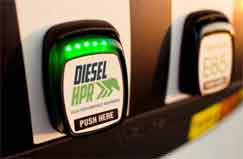Every knows traditional diesel fuel that is derived from oil. Many probably are at least familiar with the term "bio-diesel," made from vegetable oils and/or animal fats.
But the process for making bio-diesel introduces oxygen into the fuel, which can cause issues with the liquid in freezing temperatures, as well as separation during storage, algae growth in fuel tanks, and higher emissions. Bio-diesel is generally blended with petroleum diesel in a 5% to 20% ratio.
More recently has come what is called renewable diesel, also made from renewable resources such as soybean, palm, canola, or rapeseed oil; animal tallow; vegetable oil waste or brown trap grease; and other fats and vegetable oils.
The big difference versus bio-diesel is in the production process. Renewable diesel is processed similar to the way petroleum diesel is produced, which makes it chemically the same as petroleum diesel. As a result, renewable diesel doesn't contain oxygen, and therefore users will not encounter the challenges bio-diesel presents relating to freezing temperature and storage issues.
Due to the hydrogenation process used, renewable diesel also burns cleaner than bio-diesel. Perhaps most importantly, because it has the same chemical structure as petroleum diesel, renewable diesel can be used in engines that are designed to run on conventional diesel fuel, without the need for any blending.
According to GreenFleet magazine, renewable diesel comes with a number of benefits. In addition to the renewable nature of the fuel stock, it burns clean, and it works just like traditional diesel. Fleets making the switch won't encounter performance issues, nor will they need to modify equipment to adopt the fuel.
Renewable diesel is also compatible with existing diesel distribution infrastructure, meaning it can use existing pipelines, storage tanks, or retail station pumps. It can be produced using existing oil refinery capacity and does not require extensive new production facilities.
In terms of CO2, renewable diesel can reduce emissions, from 13% to as much 90% depending on the blend. Proponents also tout that if made from plants those additional feedstocks also eliminate CO2 from the air.
With all those benefits, then why hasn't renewable diesel started to really take off? The answer of course is cost.
Alternative Fuels Data Center reports that in April, the last period for which it has data, regular diesel was priced at about $2.13 per gallon, versus $2.81 for renewable diesel - a 31% premium. Regular bio-diesel was just $2.23 per gallon.
But if you operate in California, much of that delta disappears. That's because of the state's Low Carbon Fuel Standard (LCSF), which offsets some of the expense.
 That has led the city of Oakland to go all in for renewable diesel. It has been using renewable diesel in all of its diesel-powered equipment, including Fire Department apparatuses and off-road equipment, since fall of 2015. That has led the city of Oakland to go all in for renewable diesel. It has been using renewable diesel in all of its diesel-powered equipment, including Fire Department apparatuses and off-road equipment, since fall of 2015.
"We expect to displace the consumption of about 250,000 gallons of petroleum diesel and eliminate more than 1,500 tons of greenhouse gas emissions each year, and we have yet to encounter any drawbacks," Richard Battersby, manager of equipment services for the city, told GreenFleet. "The most common reaction I've experienced is disbelief that there is a cleaner burning direct diesel fuel substitute that is made from renewable sources, doesn't require any additional expense for the fuel itself, and does not require equipment and infrastructure modifications."
In July of 2015, delivery giant UPS announced it announced that it would buy as much as 46 million gallons of renewable diesel over the next three years, helping the company reach a goal of displacing 12% of the petroleum-based fuels in its ground fleet by 2017.
"It's actually as good or even better from a performance perspective as traditional diesel," including easy starts in cold weather, said Mike Whitlatch, vice president for global energy and procurement at UPS, at the time.
As with natural gas to power trucks, there is a bit of a chicken and egg scenario here, with distribution weak outside of California until demand picks up, while demand waits on supply.
Regarding that issue, Whitlatch also observed that building the market is "purely a function of how many bio-refineries are built and how much renewable diesel they can produce."
Without California-type incentives, the cost difference may simply be prohibitive for many companies and government entities in the present, however.
The hope of course is that at higher volumes, the price of renewable diesel will go down. Given all its advantages over regular diesel and bio-diesel, it seems likely renewable diesel's long term prospects are bright.
What is your take on renewable diesel? Do you believe it has a bright future? ? Let us know your thoughts at the Feedback button below.

|